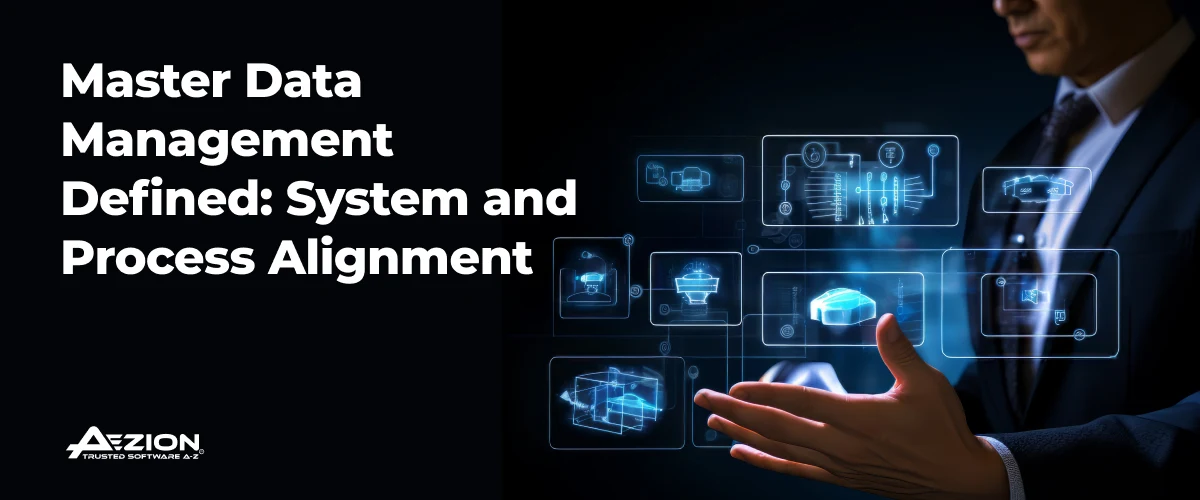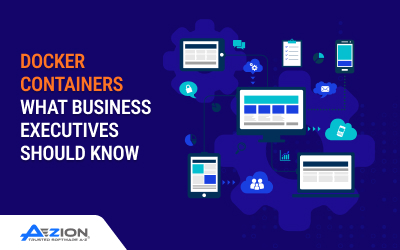Summary
Master Data Management (MDM) helps organizations unify and govern customer, product, supplier, and other important business data across disparate systems. MDM eliminates silos, minimizes duplication, ensures data is accurate, qualifies business data to support better decisions, and more efficient operations.
A good MDM strategy consists of data integration, data governance, and a single source of truth. Organizations deal with some challenges with MDM, such as fragmented data sources and poor data governance. However, these can be resolved with the right tools and processes.
Every industry, including retail, grocery, financial services, healthcare, and many others, can enhance operations and business outcomes from MDM. In addition, Aezion has specific solutions and functionality to ensure that business data aligns across all business goals and objectives and ultimately helps propel organizations in their digital transformation.
Introduction
With organizations going digital-first, consolidating and managing important business data is more important than ever. Master data management makes sure business-critical information, such as customer accounts, product catalogs, and supplier data, is controlled and in sync across systems.
By following master data across departments and systems, data engineering service providers help organizations make better decisions, automate, and innovate. Master data management is not only a technology solution, but also an enterprise transformation strategy.
In the following section, we will get into the depths of master data management and explain why it is important to enterprises.
What is Master Data Management (MDM)?
Regardless of the organization, master data sets are the fundamental business entities, e.g., customer, product, supplier, employee, etc. Master data management make sure that this data is adequately defined, governed, and made available across the enterprise.
It delivers an organized method of creating a single, authoritative view of critical data assets. This is achieved by consolidating information from different sources, cleansing and refining the data. This data is synchronized with systems afterward. With this, data engineers aim to minimize data redundancy, remove inconsistencies, and improve data quality across all business processes.
Without a formal master data management system, there are likely to be data silos, split records, and inefficiencies in business operations. MDM addresses these problems by placing data under a single higher-level governance plan to enhance business results through high-quality, standardized information.
Why Master Data Management Matters in Modern Enterprises?
Managing enterprise data effectively is the competitive differentiator in this fast-paced digital economy. Master data management is the driving force behind organizations having command of the voluminous amounts of data they generate and utilize daily.
As systems and platforms grow, opportunities for inconsistent, duplicated, or stale information multiply. Research conducted by Experian shows that 95% of companies suffer from adverse outcomes from poor data quality, including wasted resources and opportunities for growth. With a master data management approach, organizations can avoid such issues and render their data accurate, accessible, and business-focused.
A correctly implemented master data management platform can facilitate everything from digital transformation and automation to compliance and customer experience. It helps leaders make better decisions with connected, trustworthy information rather than disconnected information distributed among business units.
Key Components of an Effective Master Data Management Strategy
An effective master data management strategy depends on multiple elements that work together to enable data accuracy, consistency, and governance of master data across the organization.
- Data Integration: It is needed to bring information from disparate sources into one system. This serves to break silos and provide one picture of major data entities. Second, data quality initiatives are designed to cleanse, duplicate, and enrich to render the master data actionable and reliable.
- Data Governance: It defines policies, standards, and roles for owning and governing data assets. Over time, compliance and accountability with the integrity of master data are ensured through effective governance.
- Single and Authoritative Version: This means that all data entities are the final goal of master data management. This is the ultimate source utilized through business processes and analytics, enabling smooth execution and trusted insights.
How Master Data Management Fits into Enterprise Data Architecture: A Step-by-Step Guide
Implementing Master Data Management (MDM) in enterprise data architecture is needed to create a single, scalable, and future-proof data environment. Here’s how organizations can implement it effectively:
Step 1: Make MDM a Core Foundation
Start by making MDM the hub of your data architecture. It must be the integration layer bringing together data from different systems like ERP, CRM, transactional databases, and other systems.
Step 2: Centralize and Standardize Data
Gather master data from various sources into a centralized environment. Enforce data standards and formats to remove variations and facilitate interoperability between departments and technologies.
Step 3: Minimize Duplication and Synchronize Data Flows
Use MDM tools to identify and remove duplicate records. It synchronizes data updates in real-time across systems, so all teams get consistent, current information.
Step 4: Make Analytics and Reporting Possible
Utilize the cleansed and standardized master data as a reliable analytics, dashboards, and business intelligence source. This leads to more accurate reporting and improved forecasting.
Step 5: Extend to Hybrid and Cloud Environment
Make certain that your MDM solution can be flexible and cloud-compatible to work well across on-premises, hybrid, and multi-cloud environments without affecting data consistency.
Step 6: Future-Proof Your Data Architecture
With MDM woven into your fundamental architecture, create a data framework resilient to future technologies, business models, and regulatory requirements.
Master Data Management Challenges and How to Solve Them
Though it can change, the implementation of master data management is typically followed by several operational and strategic issues to tackle to realize standardized enterprise data accurately.
Organizations deal with duplication, outdated data, and a lack of control when dealing with complex and scattered data. The following are some key challenges and practical applications to ensure proper data management:
1) Fragmented Data in Multiple Systems
Problem: Business data is fragmented in many applications, databases, and departments, creating fragmentation and inconsistency.
Solution: Use data integration software to combine information from several platforms into a single source of truth.
2) Duplicate and Inconsistent Records
Problem: Inconsistencies in how information is captured across systems result in contradictory versions of a single entity.
Solution: Implement data matching and cleansing processes to merge records and ensure consistency.
3) Outdated or Incomplete Data
Problem: Incorrect or incomplete information can hamper business operations and decision-making.
Solution: Keep the teams updated with ongoing data quality monitoring and enrichment.
4) Lack of Governance and Accountability
Problem: Lack of ownership and policies increases the likelihood of inaccurate data.
Solution: Create robust data governance with defined stewards and uniform procedures.
5) Insufficient Cross-Departmental Collaboration
Problem: Teams could resist change or not understand how their data affects the organization.
Solution: Achieve alignment of IT and business functionality. Integrating data initiatives with the enterprise. Business objectives. By actively addressing these shared.
Advantages of Master Data Management Implementation
Here are a few key benefits of MDM:
- It offers a consistent data approach across systems, resulting in fewer data errors and better productivity.
- Companies can generate data and conduct faster and more accurate reporting, ensuring better decision-making across all levels.
- A consistent data environment improves customer experience by giving a full picture of customer interactions and behavior.
- Master data management improves regulatory compliance through accurate, auditable records, preventing expensive fines.
- It enables efficient integration of emerging technologies such as AI and analytics through reliable data foundations.
- Master data management enables organizations to innovate securely and react promptly to market developments. Thus, it is a critical part of digital transformation initiatives.
Master Data Management Use Cases Across Industries
Master data management solves key industry problems by providing accurate, consistent, governed information. The following are some in-depth use cases and examples:
1) Retail
MDM unifies product catalogs, customer profiles, etc., that allow retailers to run precise and seamless marketing strategies and manage inventory more effectively. For example, large e-commerce sites aggregate product data from multiple vendors to reduce duplication and provide consistent product descriptions.
2) Finance
Banks and insurance organizations utilize master data management to capture precise customer identities, satisfy regulatory mandates like KYC (Know Your Customer), and identify and prevent fraud. For example, master data management assists in developing a single customer view irrespective of various account forms and services.
3) Healthcare
In clinics and hospitals, master data management manages patient records, maintains accurate medical histories, and coordinates care across different departments. An example would be looking at data across pharmacies, labs, and electronic health records (EHRs) to eliminate errors and improve patient outcomes.
4) Manufacturing
Master data management facilitates supply chain management by keeping supplier information in sync, following parts, and monitoring product lifecycles. Car manufacturers commonly utilize master data management to keep part catalogs and supplier information uniform in global operations.
Telecom operators use master data management to consolidate subscriber information, automate billing, and customize offers. It prevents churn by providing customer service personnel with updated customer information.
5) Government
Government agencies consolidate citizen information using master data management to enhance service delivery and facilitate compliance with data protection legislation. Social services departments, for instance, consolidate data from various programs to deliver integrated support.
6) Energy and Utilities
Energy firms utilize master data management to keep asset information for equipment maintenance and compliance reporting. For example, correct asset records allow for timely maintenance and minimize business risks.
In all industries, master data management improves data consolidation and facilitates analytics programs, driving operational effectiveness, compliance, and better customer experiences.
Aezion’s Approach to Master Data Management
At Aezion, we recognize that successful master data management means realizing the full potential of enterprise data. Our process synergizes technical depth with strategic consulting to provide customized master data management solutions that meet your business requirements.
Our data engineering service providers begin by evaluating your existing data environment, detecting gaps in data integration, governance, and quality. Our experts then craft a solid master data management framework that guarantees data consistency, builds records, and instills solid governance habits.
Utilizing leading-edge technologies and automation, Aezion assists in data consolidation and synchronization across multiple systems, from ERP and CRM to cloud environments. This facilitates smooth data integration and underlines advanced analytics initiatives.
Best Practices for Enduring Success
Accomplishing sustainable value with master data management involves embracing best practices that keep data accurate, available, and governed long-term.
- Organizations must have solid data governance structures that spell out responsibilities, duties, and policies for data stewardship. This gives rise to accountability and stable data management.
- Ongoing data quality monitoring is critical to identify and correct duplicates, inaccuracies, and stale data before they affect business processes.
- Merging master data management enterprise systems and workflows optimizes data integration, allowing real-time synchronization and minimizing silos.
- Collaboration between business and IT teams ensures master data management efforts support strategic goals and operational requirements.
- Investment in scalable technology solutions and automation ensures efficiency while data sizes expand and business landscapes change.
Final Thoughts
As seen in this blog, effective master data management is essential for organizations keen on tapping their data assets’ power. With one reliable core business information source, organizations can enhance their operational efficiencies, improve their customer experience, and make improved decisions.
Aezion data engineering team has expertise in providing tailor-made, scalable master data management solutions, so that organizations are best positioned to ensure their data quality is retained, governance is implemented, and the organization can extract long-lasting value from their data investment.
Frequently Asked Questions:
1) What is Master Data Management?
Master data management maintains the consistency, accuracy, and governance of an organization’s master data to have a unified view of the key business entities: customers, products, and suppliers.
2) Why is Master Data Management Important?
The master data management value is that it improves data quality and consistency, decision-making, regulatory compliance, and customer experience with trusted, business-critical information.
3) What industries benefit from Master Data Management?
Retail, healthcare, financial services, manufacturing, and telecommunications are industries that benefit the most from master data management with better data integration, operational efficiencies, and more data on customers.
4) How does Aezion support Master Data Management?
Aezion delivers tailored master data management solutions that couple technology and strategic consulting to assist in attaining data accuracy, governance, and integration aligned with each organization’s business needs.
5) What does Master Data Management address?
Data fragmentation, duplicates, inconsistent records, and poor governance are addressed by master data management by giving a single source of truth with continuous data quality and control.




